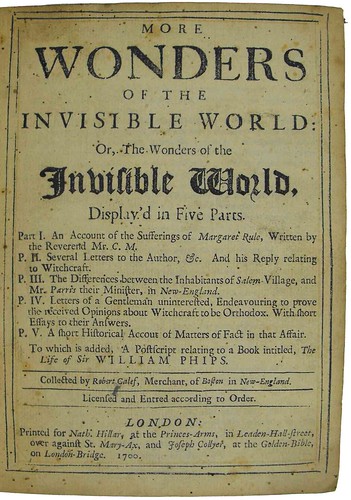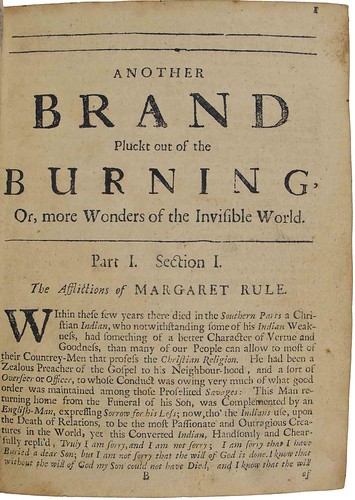Witchcraft in: North America
Mather, Increase, 1639-1723. An essay for the recording of illustrious providences ... especially in New England.
Boston in New-England, Samuel Green for Joseph Browning, 1684; octavo (Sp Coll Bi5-l.10)
Increase Mather was a Puritan minister in Boston and President of Harvard from 1685 to 1701. This work, which included demonstrations of the real existence of apparitions, spirits, and witches, is the American equivalent of Glanvill’s Saducismus triumphatus.
This copy, along with five other volumes, was donated to the University Library by the author himself. An inscription on the title page reads: "Ex Libris Universitatis Bibliothecae Glasguensis Ex Domo Authoris. 1711". On the front end-paper another inscription, apparently in Increase Mather’s own hand, reads: "For ye Library in ye University in Glasgow".
Mather, Cotton, 1663-1728. Memorable provinces relating to witchcrafts and possessions ... The second impression.
London, for Tho. Parkhurst, 1691; octavo (Sp Coll Ferguson Af-g.10)
Cotton Mather, son of Increase Mather, was also a Puritan minister at Boston. In 1688 he took into his house a child believed to be a victim of witchcraft in order to study her case. The results of his observation he published in his Memorable providences relating to witchcraft, of which the first edition was printed in Boston in 1689.
In 1710 Cotton Mather was awarded in absentia the degree of Doctor of Divinity by the University of Glasgow.
Mather, Cotton, 1663-1728. The wonders of the invisible world: being an account of the tryals of several witches lately executed in New-England ... The third edition.
London, for John Dunton, 1693; quarto (Sp Coll Ferguson Ag-c.10)
An outbreak of witch hysteria in Salem, Massachusetts, in 1692 resulted in the arrest of almost 150 people. In that year 19 persons were hanged as witches at Salem. By the following year the hysteria was on the wane, and in 1696 there appeared a confession of error by the jurors present at the trials of 1692.
Mather’s book is a semi-official narrative of a few of the Salem witch trials of 1692, and forms a justification of the convictions secured by the judges at the trials.
Calef, Robert, 1648-1719. More wonders of the invisible world.
London, for Nath. Hillar and Joseph Collyer, 1700; quarto (Sp Coll Ferguson Ah-d.29)
Calef, a Boston merchant, completed this work in 1696 but was unable to persuade any Boston printer to accept it. Hence his work was first printed in England after a delay of four years. When copies reached Boston they caused a sensation because of Calef’s attack on Cotton Mather and also because of his well-documented account of the Salem witch trials. The book was publicly burned at Harvard by Increase Mather.
Back to see books on Witchcraft and Demonology in Scotland
Forward to see a list of suggested Further Reading
Return to the Introduction page









